

Site Search
Search within product
第723号 2020 (R02) .08-09発行
Click here for PDF version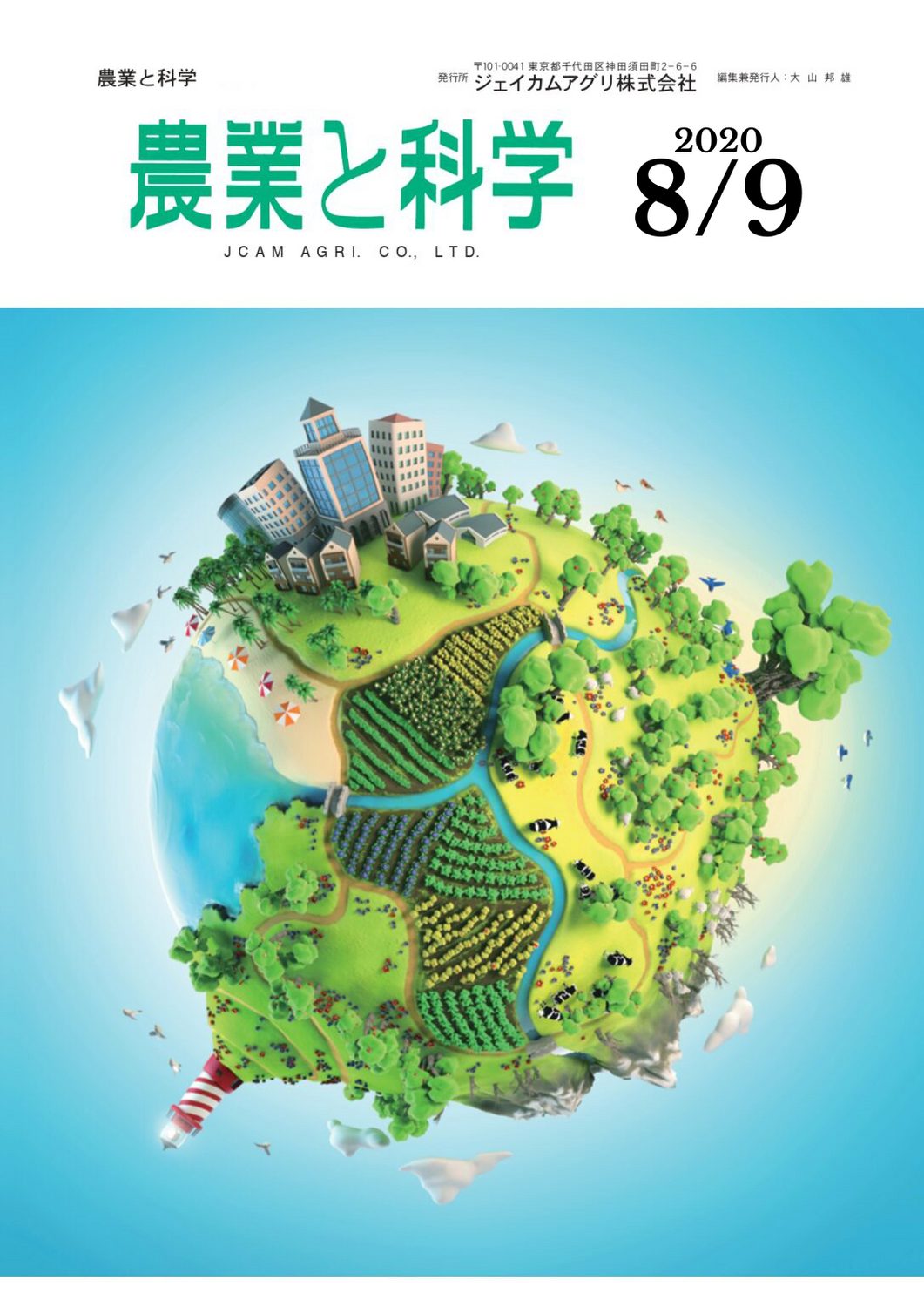
農業と科学 2020/08-09

本号の内容
§ Slow-release fertilizer at sowing in dense seedlingⓇ.
Effects of the application of "Microlong Total 280-100
Watashima Agricultural Extension Center
主査 辻 敏昭
§ Points to keep in mind for soil fertilizer management in Global GAP
宮城大学 食産業学群
齊藤 秀幸
Slow-release fertilizer at sowing in dense seedlingⓇ .
Effects of the application of "Microlong Total 280-100
Watashima Agricultural Extension Center
主査 辻 敏昭
■First Things First
In the Oshima region, located in southwestern Hokkaido, direct seeding has been promoted as a labor-saving technology for rice cultivation. In transplanting, "high-density seeding and transplanting," which reduces the number of seedling boxes to save labor during seedling cultivation and transplanting, has been introduced. The Extension Center has been working on a dense seedlingⓇ trial with the cooperation of agricultural machinery manufacturers, aiming to establish "high-density seeding and transplanting" suitable for the Watershima region.
In the trial, the seeding quantity per seedling box was 300 g of dry rice, and seedlings with about 2.1 leaves were transplanted using a dedicated transplanter after about 18 days of seeding. The dense seedlingⓇ method provides a comparable growth rate at harvest time compared to the transplanting of mat seedlings in medium-sized seedling boxes, which is common in this region, but the transplanting of young and small seedlings results in inferior initial growth and a slight delay in the growth stage.
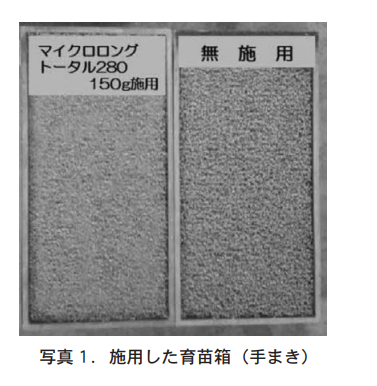
On the other hand, in our region, there is a case in which Ecolong®, a slow-release fertilizer, is applied at the time of sowing in order to omit additional fertilizer during seedling growth and to promote growth after transplanting in medium-sized seedling boxes and mats. However, the area of seedling scraping at the time of transplanting in the dense seedlingⓇ method is smaller than that in the medium seedling box-mat method, and there was concern that the large particle size of "Ecolong" might cause uneven growth of each plant because the fertilizer was not included in the scraping area. Therefore, "Microlong Total 280-100" (linear leaching, nitrogen leaching rate of 80% at 25°C soil temperature for 100 days, hereinafter abbreviated as Microlong Total), which has small particle size and leaches fertilizer even after transplanting, was used in the field for two years. (2008 and 2028). This paper reports the results.
■ Summary of Test Results
1. results for the year 2008
(1) Outline of the examination
The test was conducted at four locations, two with "Fukkunko," one with "Natsuboshi," and one with "Kitakurin. Slow-release fertilizers were applied by hand after sowing, and the amount of "Micro Long Total" applied per box was compared in three compartments: 150 g, 100 g, and no application (conventional). The amount of fertilizer applied in the field was the farmer's customary amount.
(2) Seedling quality
Seedling quality at transplanting tended to be higher in both the 150 g and 100 g sections, with longer plant height and first pod height, and slightly more leaves in both sections (Table 1, Photo 2). There were no symptoms of fertilizer burn.
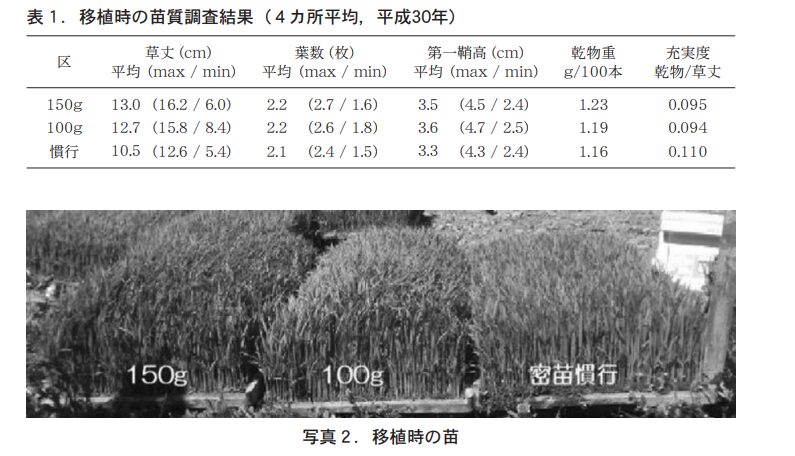
(3) Initial growth
On June 21, about one month after transplanting, the number of stems in the 150 g and 100 g compartments was generally higher than that in the conventional compartment, and the appearance of growth was also good (Table 2, Photo 3).
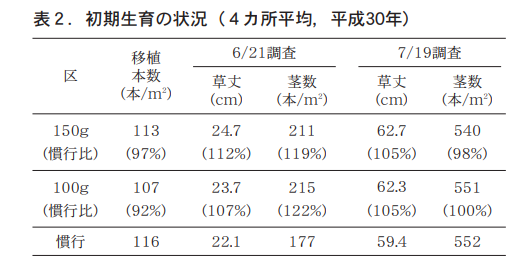
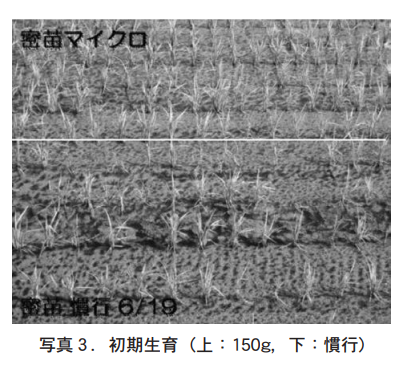
(4) Growing season section
The growth period was almost the same as that of the conventional treatment, but the ear emergence and maturity period were earlier by 1 to 2 days in the 150 g and 100 g treatments (Table 3).
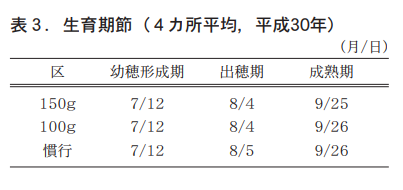
(5) Maturity stage survey
Culm and ear lengths in the 150 g and 100 g treatments were similar to those in the conventional treatments. The number of ears and the number of paddy per ear tended to be the same or slightly higher in the 150 g and 100 g compartments, and the total number of paddy was higher than that in the conventional compartments (Table 4).
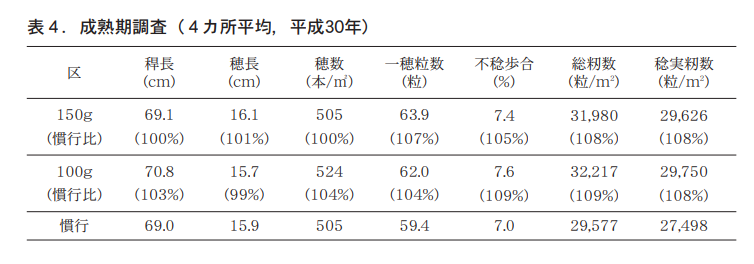
(6) Yield and quality
The yields of the 150 g and 100 g treatments tended to be similar to or slightly higher than those of the conventional treatments. The yields of the 150 g and 100 g treatments were comparable to those of the medium seedling box mats (Fig. 1).
タンパク質含有率は概ね同等の結果であった(図1) 。外観品質については,処理区間での差はなかった。
These results suggest that the application of microlong total at the time of sowing leads to improved initial growth and yield compared to the conventional dense seedlingⓇ method, and the application amount of 100 g per box seems to be effective enough.
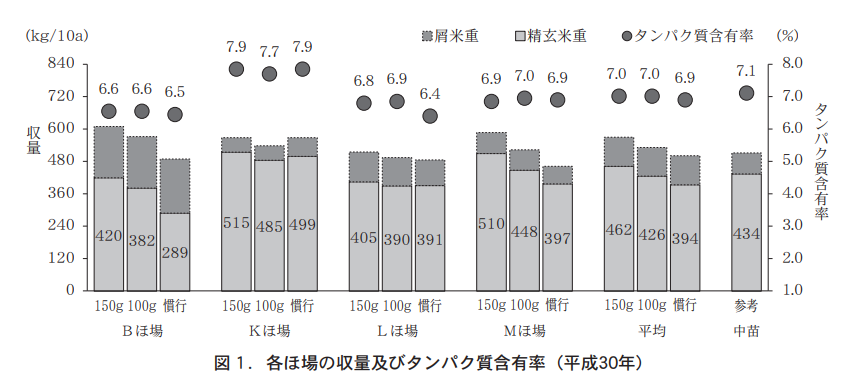
2. 2028 Results
(1) Outline of the examination
Based on the results of the previous year's test, we compared the application of "Microlong Total" in 3 areas: 100 g, 50 g, and conventional (no application). The application method used was the same as that used for medium seedling box mats, etc. (Photo 4). The test was conducted at two sites using "Fukkurinko," with a sowing date of 5/6, transplanting date of 5/25, seedling growth period of 19 days, and fertilizer application in the rice paddies in accordance with farmer practice.
(2) Seedling quality
Due to the high temperature during the seedling growth period, the 100 g and 50 g treatments with MicroLong Total grew faster than the conventional treatment, and the seedlings reached transplantable quality on the 14th day of seedling growth. Seedlings in the 100 g and 50 g treatments tended to be taller with longer grass length and first pod height at transplanting. The emergence of leaves also tended to be slightly earlier (Table 5).
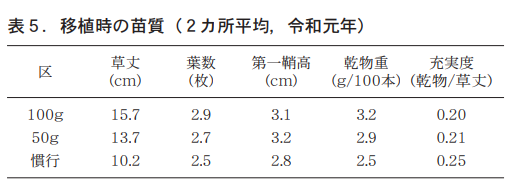
(3) Initial growth
In the June 18 survey, the number of stems in the 100 g and 50 g compartments exceeded that in the conventional compartments, and good branching was observed (Table 6, Photo 5).
In the 7/19 survey, the number of stems in the conventional plot increased and was almost equal to the number of stems in the 50g plot. The number of ears at maturity increased in the order of 100 g, conventional, and 50 g (Table 6).
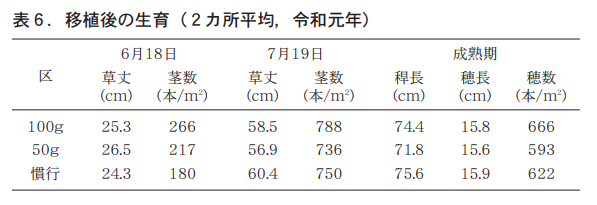
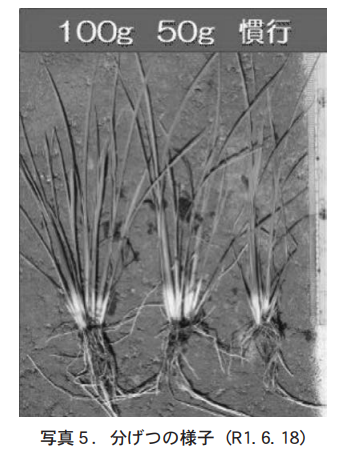
(4) Growing season section
The growth time nodes were almost the same, but tended to be slightly earlier in the 100 g plot (Table 7).
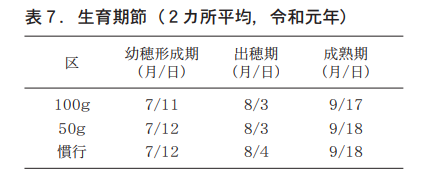
(5) Yield components
In the ripening survey, the number of ears was higher in the 100 g plot, but the number of paddy per ear was slightly lower. The total number of paddy rice was not significantly different among the three areas (Table 8).

(6) Yield and quality
The yields of the 100 g and 50 g compartments tended to be slightly higher than those of the conventional compartment, and the protein content was almost the same (Figure 2).
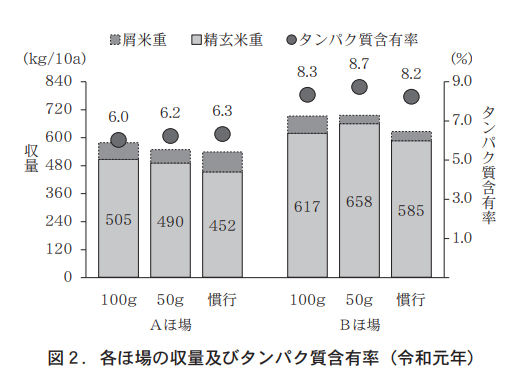
■ Summary
The results of two years using paddy rice varieties such as "Fukkunko" showed that the application of Micro Long Total at the time of sowing improved the early growth of the rice. The improvement in early growth leads to the securing of yield components such as the number of ears and the total number of paddy rice grains, and thus, higher yields can be expected.
When using this product, it is necessary to pay sufficient attention to temperature control during the seedling growth period because the seedlings tend to grow taller.
In the case of "Microlong Total 280-100" used in this study, 100 g/box was expected to be sufficient. We will continue to study the effective use of Micro Long Total to ensure stable yield and quality in high-density seeding and transplanting, which is a labor-saving technology.
Dense Seedling" is a registered trademark of Yanmar Co.
Considerations for Soil Fertilizer Management in Global GAP
宮城大学 食産業学群
齊藤 秀幸
Introduction
The Tokyo 2020 Olympic and Paralympic Games have triggered a growing interest in Global GAP in agricultural production. However, it seems that the specific details of Global GAP are not well understood due to the prevailing image that "it looks difficult" or "it looks troublesome. In addition, although the term "global GAP" is thought to have a strong image of pesticide residue testing, it is in fact a certification standard with a large weight on soil fertilizer management. Therefore, in this report, I would like to describe from this perspective based on the author's certification experience (certification acquired in December 2018 and December 2019).
What is GAP?
GAP is an abbreviation for Good Agricultural Practice, a production process management approach to ensure the sustainability of (1) food safety, (2) traceability, (3) quality control, (4) labor safety and health, (5) soil management, (6) fertilizer application management, (7) integrated pest management (IPM), (8) pesticide management, and (9) water management in agriculture (Saito et al. GAP is a production process management approach to ensure sustainability in (Saito et al., 2020; Figure 1). Among them, Global GAP (official name GLOBALG.A.P.) is a certification standard by FoodPLUS GmbH, a private organization based in Cologne, Germany (Saito et al., 2020).
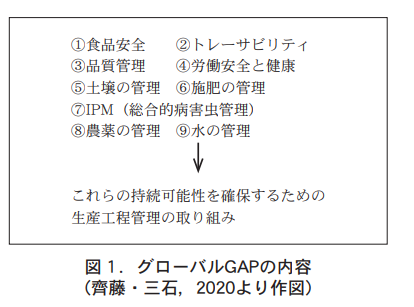
グローバルGAPの歴史は1997年に始まる(図2) 。1997年,欧州のいくつかの大手流通業者がEUREPGAP(EUREP = Euro-Retailer WorkingGroup;欧州小売業者ワーキンググループ)を作成した。当時,サルモネラ,病原性大腸菌,BSE,鳥インフルエンザ等が世界的に社会問題となっていた。大手流通業者としては生産者等にその防止措置を求める意図があったようである。2007年にはEUREPGAPがGLOBALG.A.Pに名称変更され,2010年にはGFSI認証を受けて今日に至っている(図2) 。
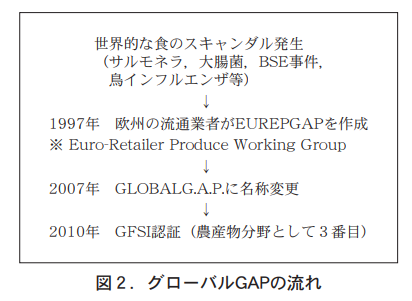
The Global Food Safety Initiative (GFSI) is a private organization of global food-related companies that work together to approve food safety management standards with the aim of improving food safety and strengthening consumer confidence. GFSI is a private organization of food-related companies from around the world. Aeon is one of the Japanese members. In other words, the endorsement of GFSI allows a company to call itself an international food safety management standard. Currently, Global GAP has spread to more than 120 countries around the world and has become one of the de facto international standards (Saito et al., 2020).
日本におけるGAP認証は,JGAP,ASIAGAP,グローバルGAPの3種が知られている。これらは運営主体が異なり,JGAPおよびASIAGAPは(一財)日本GAP協会が行い,グローバルGAPは前述のようFoodPLUS GmbH(ドイツ)が指定した審査機関が審査を実施している。JGAPは従来BasicとAdvanceの2本立てであったが,後者は平成30年10月31日にGFSIの認証を取得し(齊藤ら,2019) ,ASIAGAPとしてグローバルGAPとの同等性が認められている。国内における認証取得経営体数は,平成31年3月末現在,JGAPが2,851,ASIAGAPが1,869,グローバルGAPが702である(農林水産省HP,2020)。
Initiatives at Miyagi University
Tsubonuma Farm, affiliated with Miyagi University's School of Food Science and Industry, began working toward acquiring Global GAP in 2017 as one of the pillars of its education and research. However, the efforts made slow progress. There are two main reasons for this.
1)新たな業務に対する現場の戸惑いが大きく,なかなかグローバルGAPに対する具体性をイメージできなかった点。
2)グローバルGAPの認証取得を検討する生産者の急激な増加により,コンサルタント会社も多忙になり,大学側の予定との日程調整に苦労した点。
Therefore, it was not until the second half of 2017 that a full-scale effort, including the reorganization of the site, was initiated.
The reasons for selecting leeks as the target commodity are as follows.
(1) It is hardy and easy to grow.
(2) Longer harvesting period. (3) Longer time to respond to screening.
(3) A wide range of stages from leafy green onions to deep-rooted green onions can be selected.
(4) The number of irrigation and fertilizer application can be reduced, and the complexity of record keeping can be avoided.
(5) It is resistant to pests and can reduce the frequency of pesticide spraying.
(6) There is a nearby producer of green onions that has obtained Global GAP certification, and we can refer to their know-how.
第1回目の審査は2018年11月8日〜9日に行われ,是正項目なしで認証され(2018年12月1日〜2019年11月30日まで有効) ,第2回目の審査は2019年11月8日に行われ,是正項目なしで認証された(2019年12月1日〜2020年11月30日まで有効) 。グローバルGAPの審査は毎年行われる。
The main on-site conditions at Tsubonuma Farm affiliated with Miyagi University are shown in Photos 1 through 5. At the entrance of the administration building (office), the on-site hygiene procedures are indicated, and visitors are asked to write their names, the purpose of their visit, and the time of their visit on a record form (Photo 1). The sanitation procedures include the washing of hands and the prohibition of entry of persons suffering from infectious diseases. AED manuals, first aid manuals, and information on allergenic items are posted in the corridor of the administration building (Photo 2). Incidentally, the author has received training on the use of AED at the request of Global GAP.
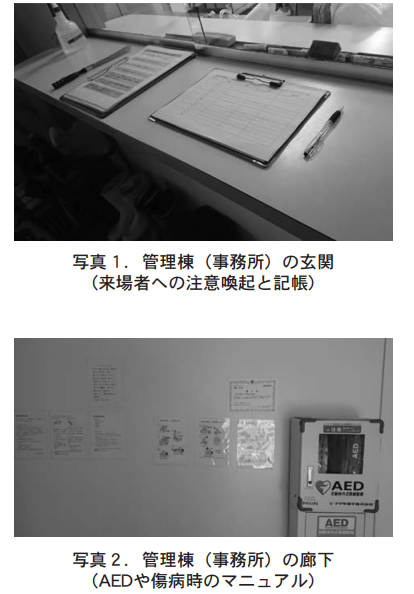
Outside, the fertilizer and soil storage areas are separated into those related to Global GAP plots and those not related to Global GAP plots, and changes in quantities are recorded (Photo 3). Pesticides are stored and mixed in designated areas, and in the pesticide storage area, each liquid and granular formulation is separated and placed in trays to prevent loss and scattering (Photo 4). The disposal site for pesticide rinsing liquid is also set in one place (Photo 4). Global GAP plots are housed in plastic greenhouses to prevent drift (Photo 5). The amount of irrigation and irrigation time are recorded. Harvested products are shipped and prepared in separate locations for Global GAP items (green onions) and other items (Photo 6).
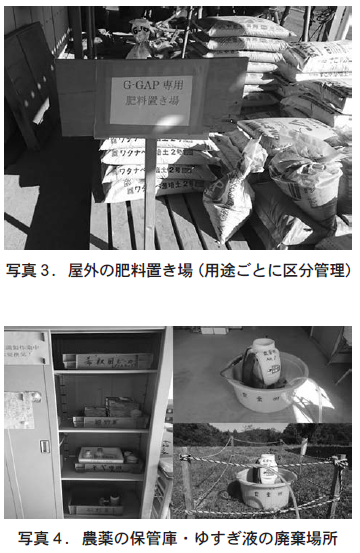
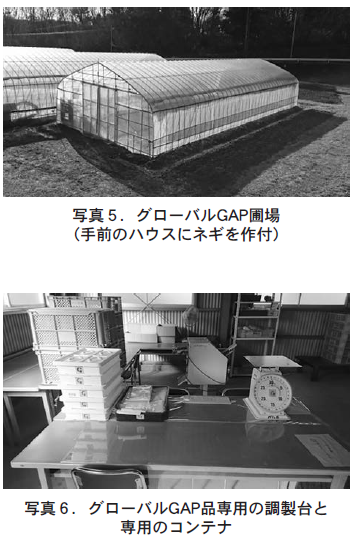
When collecting and preparing the green onions, they change their boots and gloves, and the containers used for harvesting and shipping are separated for Global GAP items (green onions) and other items. To prevent contamination by allergens, we use adhesive cleaners to clean clothes as needed. In the sorting room (shipping control station), hygiene procedures, a manual for waste disposal, and a checklist for cleaning are posted (Photo 7). In this way, the farm always recognizes that its produce is food, and strives to manage sanitation as much as possible. In addition, various cultivation records and loss ratios of produce are also kept.
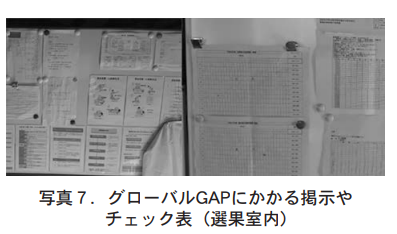
4. Composition of Global GAP
Global GAP consists of (1) hygiene management, (2) QMS (Quality Management System; quality of management system), (3) worker welfare, and (4) sustainability (Figure 3). Hygiene control is considered to be HACCP-like and is divided into physical, biological, and chemical risks (Figure 3). Although each risk cannot be completely eliminated, efforts should be made to minimize them as much as possible.
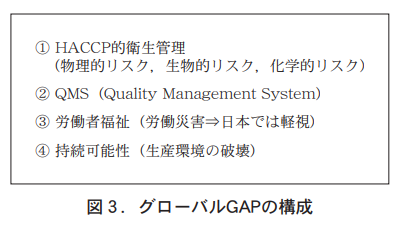
5. global GAP from a soil fertilizer perspective
Soil fertilizer management plays an extremely important role in crop management. From the author's point of view, it can be categorized as follows.
(1) History of the farmland; for example, if it was in the vicinity of a factory or mine, there is a high risk of chemical contamination. Also, if immature compost is applied, there is a risk of growth of pathogenic E. coli bacteria, and thus a biological risk. It seems that Global GAP requires strict checks on the safety of animal organic materials. Furthermore, there is the possibility of landslides, such as if the land was damaged by an earthquake or was a landfill site, and physical risks need to be considered.
(2) Check soil quality; macroscopically, the soil classification of the area where the field is located should be checked (Takata, 2020) and the geological basis of the soil should be understood. Microscopically, it is necessary to conduct an accurate soil analysis and confirm the data. Taking these results into consideration, it is necessary to specify an improvement plan according to the weak points. For example, in the case of poor drainage, sub-soiling or the introduction of green manure crops may be considered.
(iii) Soil disinfection records; 5W1H records are essential. It is also necessary to clearly indicate how to dispose of empty containers and where to dispose of rinsing liquid. It is also important to ensure that contamination of rivers does not occur.
Check for fertilizers; obtain SDS (Safety Data Sheet) if possible (not required). This will clarify safety. For organic fertilizers, it is necessary to confirm that they have been properly sterilized. On the other hand, it is also important to confirm that education and training are conducted in consideration of the health of the sprayers (masks and gloves for spraying, etc.). It is also important to confirm that inventory control is properly conducted.
(5) Avoidance of crop damage; Global GAP is also concerned with the question of whether sustainable agricultural management is being implemented. Avoidance of row crop damage is important, and the plan for this point should be clarified. Prevention of soil-borne diseases overlaps with the perspective of IPM (Integrated Pest Management).
Checklist at Miyagi University
Global GAP checks three areas: All Farm Base (AF), Crops Base (CB), and Fruit and Vegetables (FV) (Figure 4). Of the more than 200 items published in the standard list, high priority items must be observed at least 1001 TP3T and low priority items must be observed at least 951 TP3T. In addition to these items, there are items that should be voluntarily self-inspected if possible, but these are not required for the time being if only certification is obtained. However, these items that are acceptable on a voluntary basis may be upgraded to mandatory items in the future.
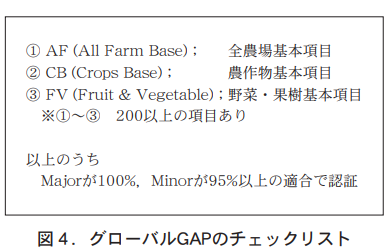
The Tsubonuma farm had about 10% of the exemptions, but this is because it does not produce genetically modified crops and does not use soil disinfection, so it was not necessary to deal with these issues.
7. impressions of the screening process (in closing)
Global GAP is not a set of clear numerical standards, and it is not a matter of checking whether or not the standards have been met. The actual audit reflects the individuality of the auditor, which is not necessarily a single discipline. The actual judging reflects the individuality of the judges and is not necessarily uniform. The backgrounds of the judges vary, and if, for example, a judge has expertise in soil fertility, he or she may conduct a very detailed investigation.
On the other hand, in Europe and the United States, there seems to be a stronger sense of caution against pathogenic E. coli than in Japan. This seems to be reflected in the Global GAP assessment. Cattle manure is considered to have a high risk of pathogenic E. coli, and I have the impression that they strictly check whether fully ripened manure is used or not. Incidentally, we (Tsubonuma Farm) confirmed that during the fermentation process, the temperature remained above 60°C for more than 30 minutes. In Europe and the United States, standards for organic farming are clearer than in Japan (Nishio, 2019). In the case of Japan, it is difficult to say that attention is paid to safety in accordance with domestic laws (regulations), and in this respect, the insight of each producer is questioned. It is necessary to clarify on what scientific basis the attention is paid.
Global GAP audits are conducted annually and are valid for one year. I have the impression that the hurdles are getting higher every year. In short, the audit is conducted every year to see if "kaizen" is observed. As mentioned earlier, the items on the checklist are updated frequently, and efforts must be made to collect the latest information.
Fortunately, so far we have been able to obtain certification without corrective action, but it is not without its challenges (in principle, a corrective action report is required within 28 days if corrective action is requested). It is always accompanied by a sense of tension and requires a lot of energy. Certainly, the content required by Global GAP is not advanced (many certifications seem to be in developing countries), and it is not a high hurdle for producers who are serious about their work. Although the cost of the audit is not cheap, the inventory control has eliminated wasteful purchases. Many producers cite this point as an advantage.
In Japan, the 2020 Tokyo Olympics and Paralympics have become an opportunity to focus attention on GAP, and the demand for food safety is increasing. More and more distributors in Japan are taking an interest in GAP. The importance of GAP is expected to increase even after the Tokyo Olympics. It is still an urgent need to respond to this trend.
Acknowledgements
We would like to thank Mr. Akira Suno of Farm Alliance Management, Inc. We would like to express our sincere gratitude to him.
9. literature
1)齊藤秀幸・三石誠司.2020.
つくる責任を担保する(G-GAPとSDGs) .
フードシステム研究.26(4);247〜252.
(2) Ministry of Agriculture, Forestry and Fisheries, "Status of Efforts by Prefectures.
https://www.maff.go.jp/j/seisan/gizyutu/gap/kengap.html(2020年3月1日閲覧)
3)高田裕介.2020.
日本土壌インベントリー(e−土壌図Ⅱ)が目指す土壌情報の発信.
農業と科学.718;1−5.